1 min read
Stephan’s Quintet (NIRCam and MIRI Composite Image)
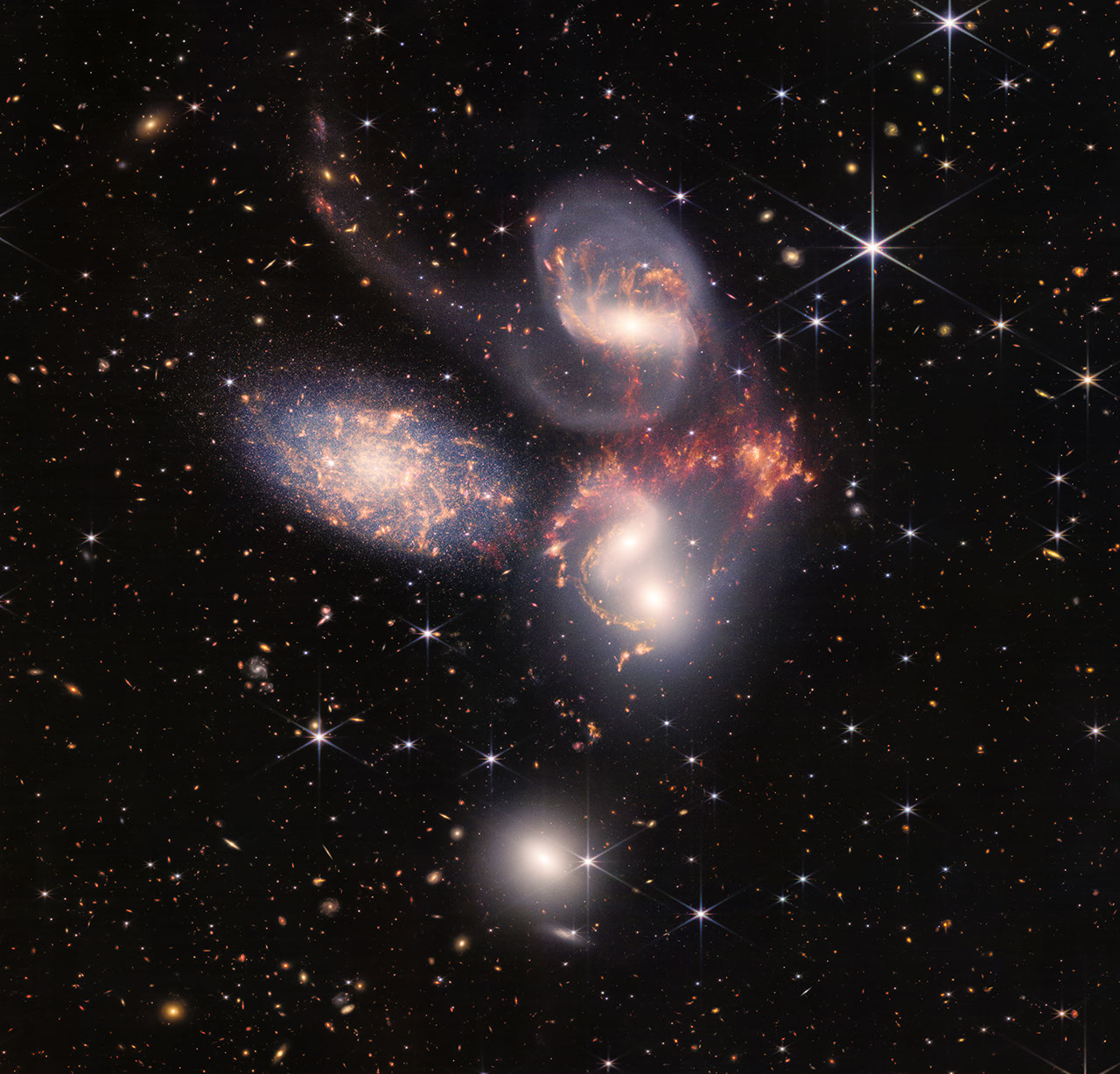
An enormous mosaic of Stephan’s Quintet is the largest image to date from NASA’s James Webb Space Telescope, covering about one-fifth of the Moon’s diameter. It contains over 150 million pixels and is constructed from almost 1,000 separate image files. The visual grouping of five galaxies was captured by Webb’s Near-Infrared Camera (NIRCam) and Mid-Infrared Instrument (MIRI).
With its powerful, infrared vision and extremely high spatial resolution, Webb shows never-before-seen details in this galaxy group. Sparkling clusters of millions of young stars and starburst regions of fresh star birth grace the image. Sweeping tails of gas, dust and stars are being pulled from several of the galaxies due to gravitational interactions. Most dramatically, Webb’s MIRI instrument captures huge shock waves as one of the galaxies, NGC 7318B, smashes through the cluster. These regions surrounding the central pair of galaxies are shown in the colors red and gold.
This composite NIRCam-MIRI image uses two of the three MIRI filters to best show and differentiate the hot dust and structure within the galaxy. MIRI sees a distinct difference in color between the dust in the galaxies versus the shock waves between the interacting galaxies. The image processing specialists at the Space Telescope Science Institute in Baltimore opted to highlight that difference by giving MIRI data the distinct yellow and orange colors, in contrast to the blue and white colors assigned to stars at NIRCam’s wavelengths.
Together, the five galaxies of Stephan’s Quintet are also known as the Hickson Compact Group 92 (HCG 92). Although called a “quintet,” only four of the galaxies are truly close together and caught up in a cosmic dance. The fifth and leftmost galaxy, called NGC 7320, is well in the foreground compared with the other four. NGC 7320 resides 40 million light-years from Earth, while the other four galaxies (NGC 7317, NGC 7318A, NGC 7318B, and NGC 7319) are about 290 million light-years away. This is still fairly close in cosmic terms, compared with more distant galaxies billions of light-years away. Studying these relatively nearby galaxies helps scientists better understand structures seen in a much more distant universe.
This proximity provides astronomers a ringside seat for witnessing the merging of and interactions between galaxies that are so crucial to all of galaxy evolution. Rarely do scientists see in so much exquisite detail how interacting galaxies trigger star formation in each other, and how the gas in these galaxies is being disturbed. Stephan’s Quintet is a fantastic “laboratory” for studying these processes fundamental to all galaxies.
Tight groups like this may have been more common in the early universe when their superheated, infalling material may have fueled very energetic black holes called quasars. Even today, the topmost galaxy in the group – NGC 7319 – harbors an active galactic nucleus, a supermassive black hole that is actively accreting material.
In NGC 7320, the leftmost and closest galaxy in the visual grouping, NIRCam was remarkably able to resolve individual stars and even the galaxy’s bright core. Old, dying stars that are producing dust clearly stand out as red points with NIRCam.
The new information from Webb provides invaluable insights into how galactic interactions may have driven galaxy evolution in the early universe.
As a bonus, NIRCam and MIRI revealed a vast sea of many thousands of distant background galaxies reminiscent of Hubble’s Deep Fields.
NIRCam was built by a team at the University of Arizona and Lockheed Martin’s Advanced Technology Center.
MIRI was contributed by ESA and NASA, with the instrument designed and built by a consortium of nationally funded European Institutes (The MIRI European Consortium) in partnership with JPL and the University of Arizona.
For a full array of Webb’s first images and spectra, including downloadable files, please visit: https://webbtelescope.org/news/first-images
Extended Description and Image Alt Text
Extended Description
Image of a group of five galaxies that appear close to each other in the sky: two in the middle, one toward the top, one to the upper left, and one toward the bottom. Four of the five appear to be touching. One is somewhat separated. In the image, the galaxies are large relative to the hundreds of much smaller (more distant) galaxies in the background. All five galaxies have bright white cores. Each has a slightly different size, shape, structure, and coloring.
At the center of the image are two bright galaxy cores with orange wisps surrounded by a cloud-like aura of white. The cores are close to each other and there is no clear boundary between the galaxies. The top galaxy of the pair has two spiral arms and the other is more elliptical in shape.
The galaxy toward the top of the image has a bright central core, surrounded by orange wisps and tendrils. The core is surrounded by a thin cloud-like aura of white that forms a diffuse spiral arm-like structures that trails off toward the upper left.
Between the top and center galaxies is a large region of bright orange.
The galaxy toward the bottom of the image sits alone, not appearing to touch any of the other four. It is nearly circular in shape and has a bright core surrounded by a cloud-like aura of white. This galaxy is almost completely white: No orange wisps or arms are apparent.
The galaxy toward the upper left has a fuzzy oval shape, with more distinct points of light than are apparent in the other four galaxies. Within the oval is a bright core with orange wisps and a vague spiral structure. The core of this galaxy is not as bright or distinct as the cores of the other four galaxies.
In the background of the image are numerous smaller, more distant galaxies of various colors, shapes, sizes, and brightness. Scattered across the image, in front of the galaxies are number of foreground stars with diffraction spikes: bright white points, each with eight bright lines radiating out from the center. The sizes of the stars and diffraction spikes vary. Some are superimposed on the large galaxies. The largest is to the upper right of the group of galaxies.
Image Alt Text
Colorful image of the near- and mid-infrared light of a group of galaxies, with hundreds of background galaxies and numerous foreground stars.
About the Object
- R.A. PositionR.A. PositionRight ascension – analogous to longitude – is one component of an object's position.22:35:57.49
- Dec. PositionDec. PositionDeclination – analogous to latitude – is one component of an object's position.33:57:36.0
- ConstellationConstellationOne of 88 recognized regions of the celestial sphere in which the object appears.Pegasus
- DistanceDistanceThe physical distance from Earth to the astronomical object. Distances within our solar system are usually measured in Astronomical Units (AU). Distances between stars are usually measured in light-years. Interstellar distances can also be measured in parsecs.290 million light-years (89 million parsecs)
- DimensionsDimensionsThe physical size of the object or the apparent angle it subtends on the sky.Image is about 7.4 arcmin across (about 620,000 light-years)
About the Data
- Data DescriptionData DescriptionProposal: A description of the observations, their scientific justification, and the links to the data available in the science archive.
Science Team: The astronomers who planned the observations and analyzed the data. "PI" refers to the Principal Investigator.This image was created with Webb data from proposal 2732. It is part of Webb Early Release Observations.
The Early Release Observations and associated materials were developed, executed, and compiled by the ERO production team:
Jaclyn Barrientes, Claire Blome, Hannah Braun, Matthew Brown, Margaret Carruthers, Dan Coe, Joseph DePasquale, Nestor Espinoza, Macarena Garcia Marin, Karl Gordon, Alaina Henry, Leah Hustak, Andi James, Ann Jenkins, Anton Koekemoer, Stephanie LaMassa, David Law, Alexandra Lockwood, Amaya Moro-Martin, Susan Mullally, Alyssa Pagan, Dani Player, Klaus Pontoppidan, Charles Proffitt, Christine Pulliam, Leah Ramsay, Swara Ravindranath, Neill Reid, Massimo Robberto, Elena Sabbi, Leonardo Ubeda.
The EROs were also made possible by the foundational efforts and support from the JWST instruments, STScI planning and scheduling, Data Management teams, and Office of Public Outreach.
- InstrumentInstrumentThe science instrument used to produce the data.NIRCam, MIRI
- Exposure DatesExposure DatesThe date(s) that the telescope made its observations and the total exposure time.NIRCam: 11 June 2022; MIRI: 11-12 June, 1 July 2022
- FiltersFiltersThe camera filters that were used in the science observations.NIRCam>F090W, F150W, F200W, F277W, F365W, F444W MIRI>F770W, F1000W
- Object NameObject NameA name or catalog number that astronomers use to identify an astronomical object.Stephan’s Quintet, Hickson Compact Group (HCG) 92, NGC 7318A, NGC 7318B, NGC 7319, NGC 7320
- Object DescriptionObject DescriptionThe type of astronomical object.Interacting Galaxy Group
- Release DateJuly 12, 2022
- Science ReleaseNASA’s Webb Sheds Light on Galaxy Evolution, Black Holes
- CreditImage: NASA, ESA, CSA, STScI
Downloads

These images are a composite of separate exposures acquired by the James Webb Space Telescope using the MIRI and NIRCam instruments. Several filters were used to sample broad wavelength ranges. The color results from assigning different hues (colors) to each monochromatic (grayscale) image associated with an individual filter. In this case, the assigned colors are: Red: F356W+ F444W Orange: F1000W Yellow: F277W + F770W Green: F200W Blue: F090W + F150W

Related Images & Videos
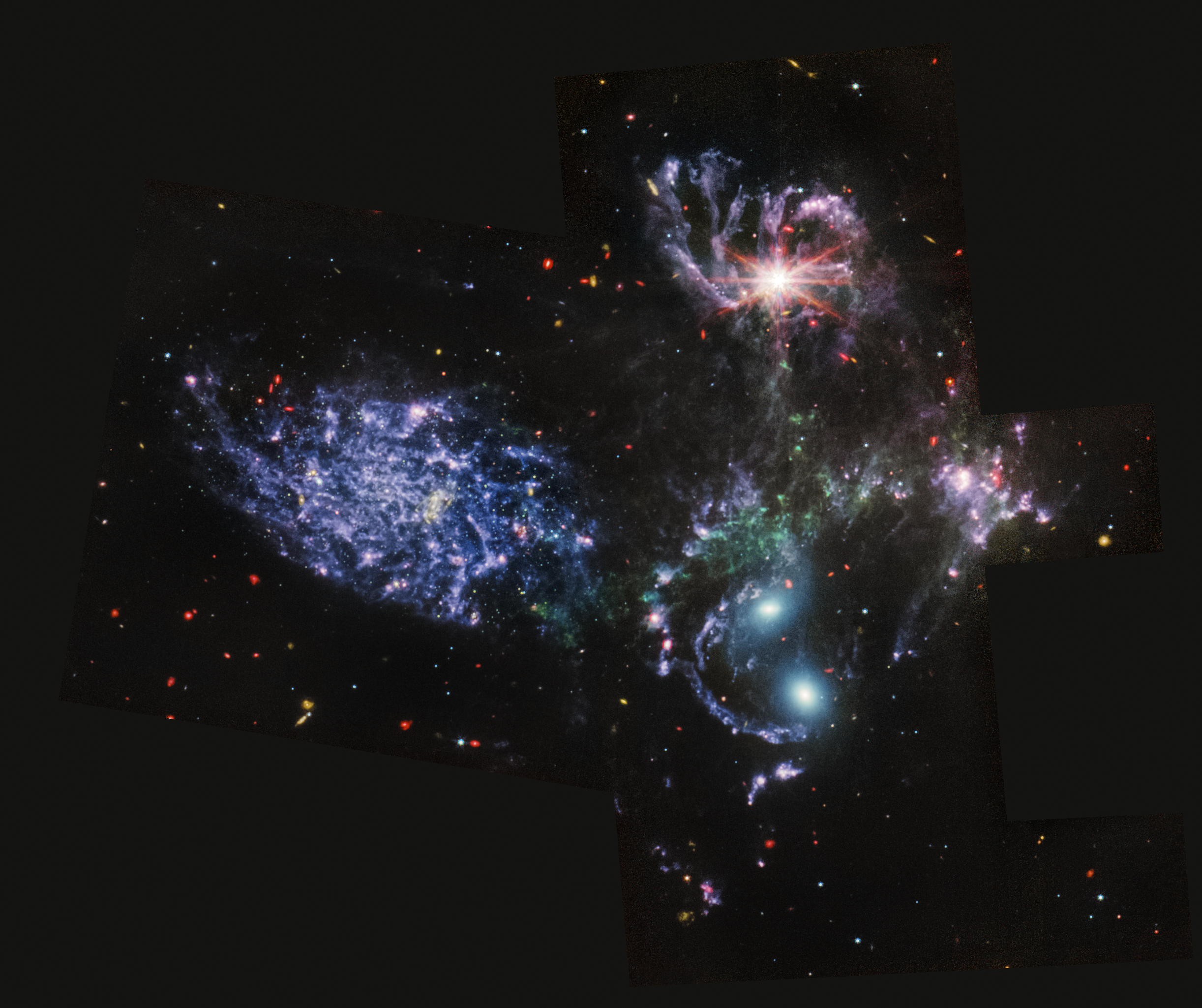
Stephan's Quintet (MIRI Image)
With its powerful, mid-infrared vision, the Mid-Infrared Instrument (MIRI) shows never-before-seen details of Stephan’s Quintet, a visual grouping of five galaxies. MIRI pierced through dust-enshrouded regions to reveal huge shock waves and tidal tails, gas and stars stripped...
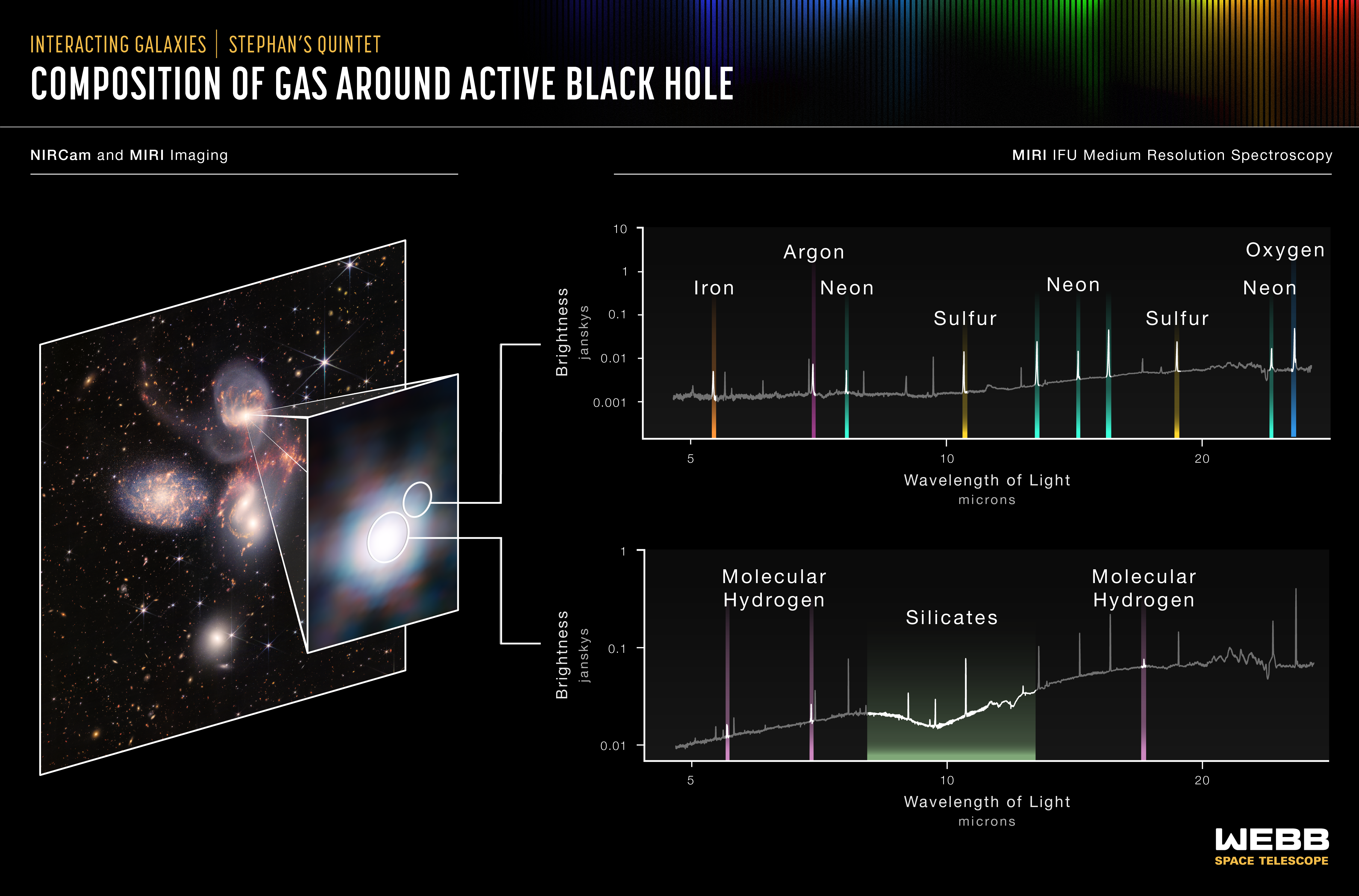
Stephan's Quintet (MIRI Spectra)
Stephan’s Quintet is a visual grouping of five galaxies located in the constellation Pegasus. Together, they are also known as the Hickson Compact Group 92 (HCG 92). Although called a “quintet,” only four of the galaxies are truly close together and caught up in a cosmic dance....
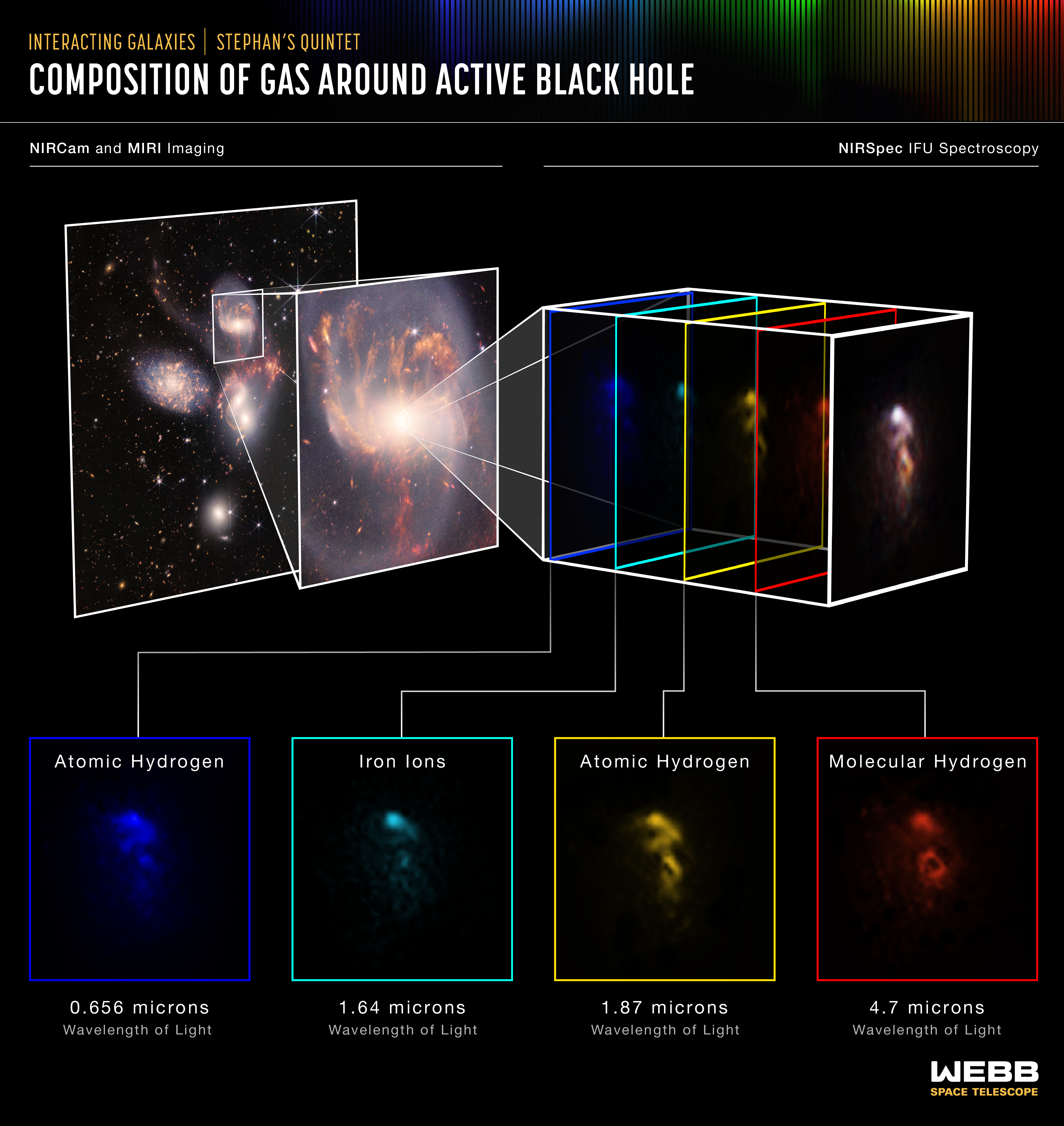
Stephan's Quintet (NIRSpec IFU)
Stephan’s Quintet is a visual grouping of five galaxies located in the constellation Pegasus. Together, they are also known as the Hickson Compact Group 92 (HCG 92). Although called a “quintet,” only four of the galaxies are truly close together and caught up in a cosmic dance....
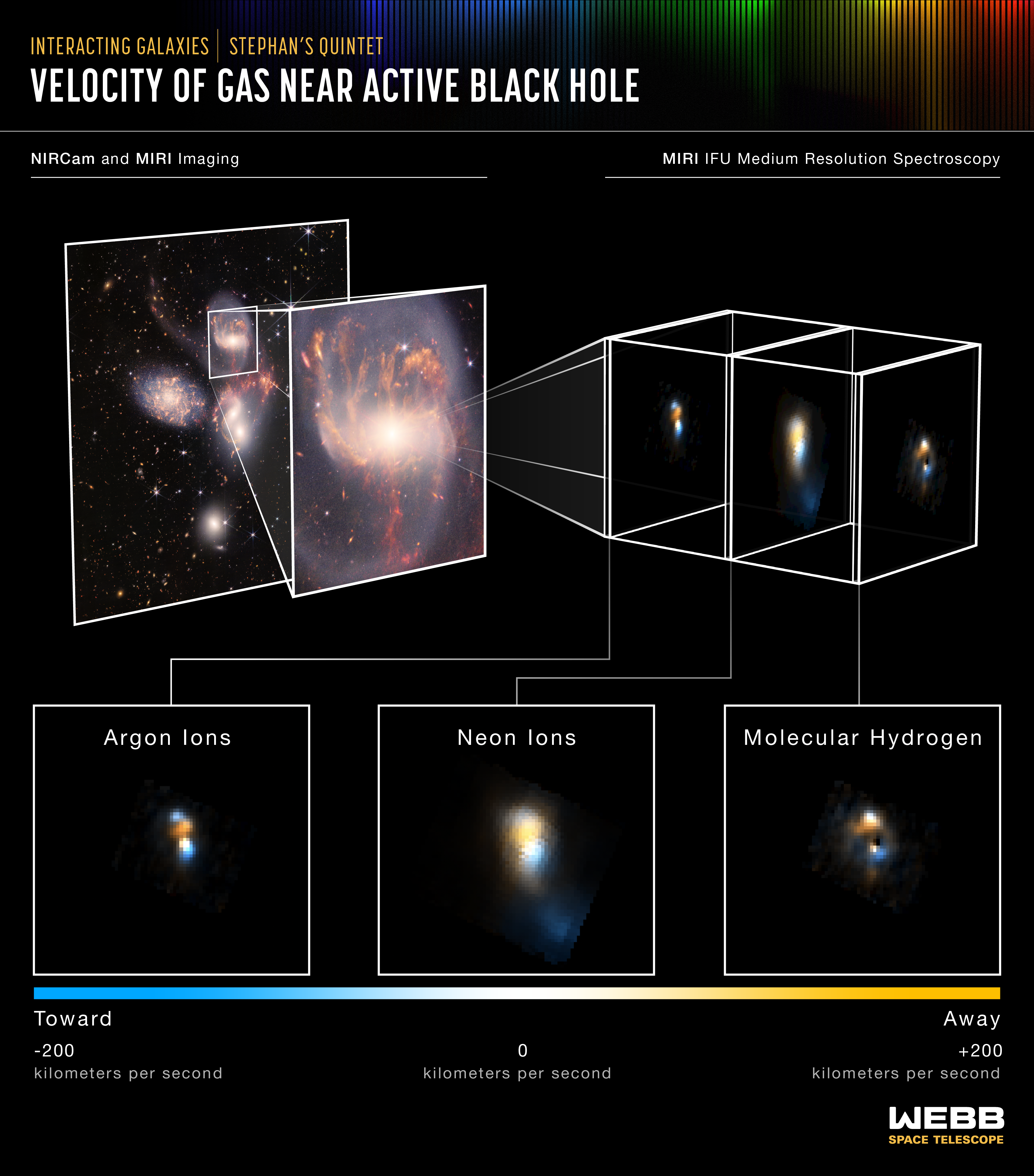
Stephan's Quintet (MIRI IFU)
Stephan’s Quintet is a visual grouping of five galaxies located in the constellation Pegasus. Together, they are also known as the Hickson Compact Group 92 (HCG 92). Although called a “quintet,” only four of the galaxies are truly close together and caught up in a cosmic dance....
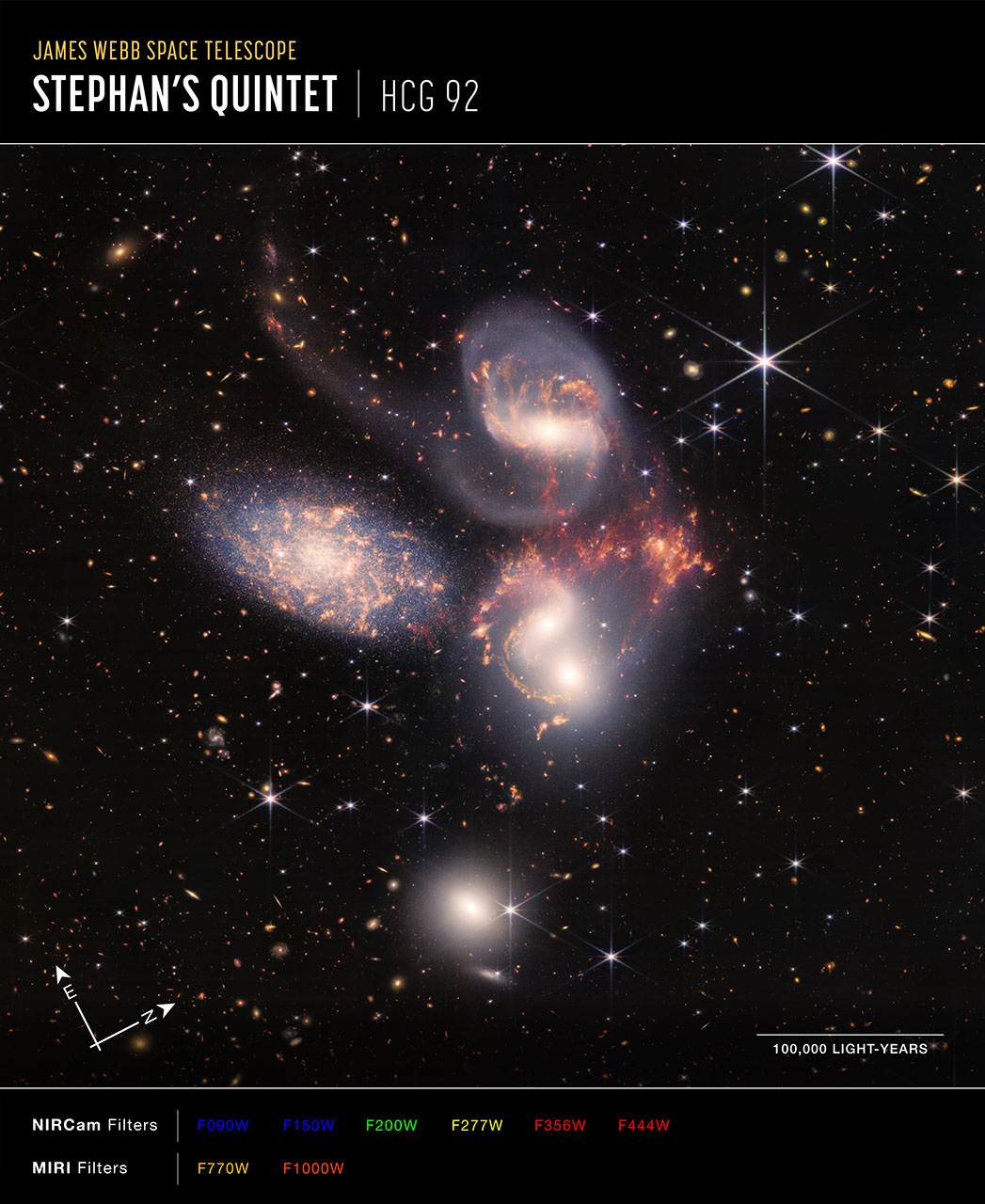
Stephan's Quintet (NIRCam and MIRI Composite Compass Image)
Image of Stephan's Quintet, HCG 92, captured by Webb’s Near-Infrared Camera (NIRCam) and Mid-Infrared Instrument (MIRI), with compass arrows, scale bar, and color key for reference. The north and east compass arrows show the orientation of the image on the sky. Note that the...
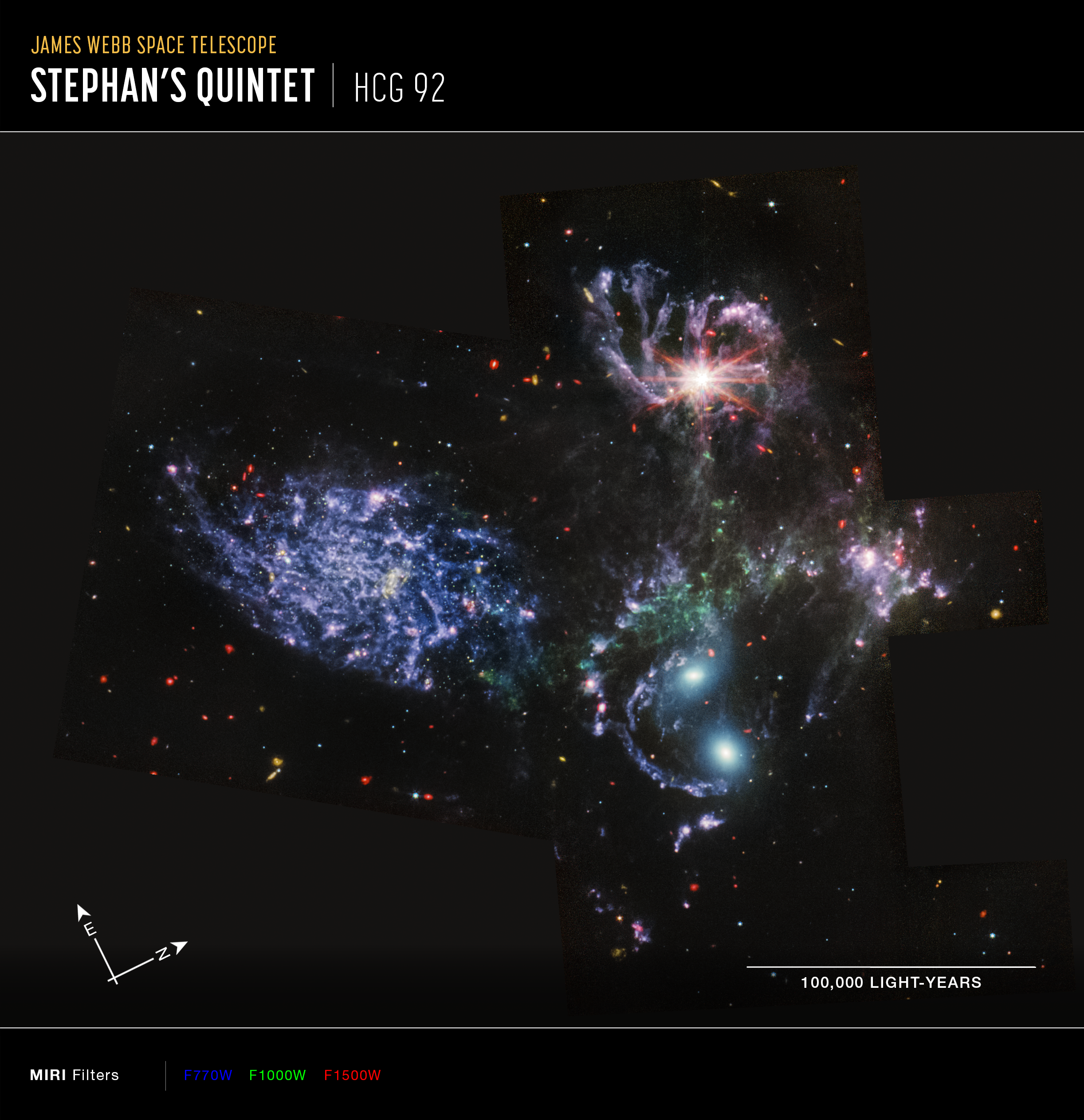
Stephan's Quintet (MIRI Compass Image)
Image of Stephan's Quintet, HCG 92, captured by Webb’s Mid-Infrared Instrument (MIRI), with compass arrows, scale bar, and color key for reference. The north and east compass arrows show the orientation of the image on the sky. Note that the relationship between north and east...
Share
Details
Laura Betz
NASA’s Goddard Space Flight Center
Greenbelt, Maryland
laura.e.betz@nasa.gov
NASA, ESA, CSA, STScI






























